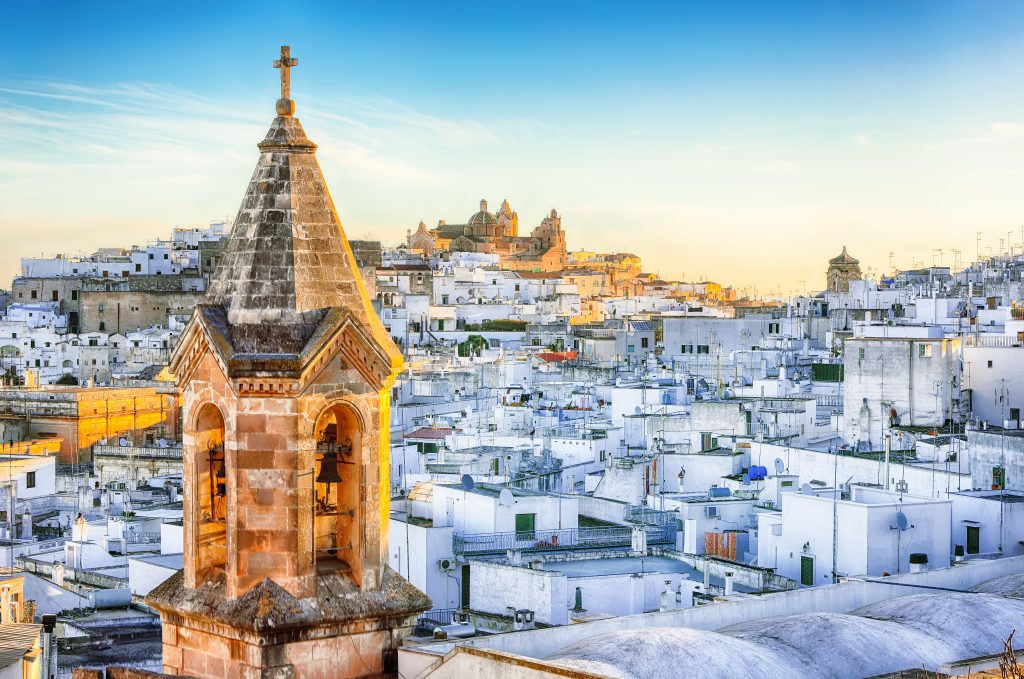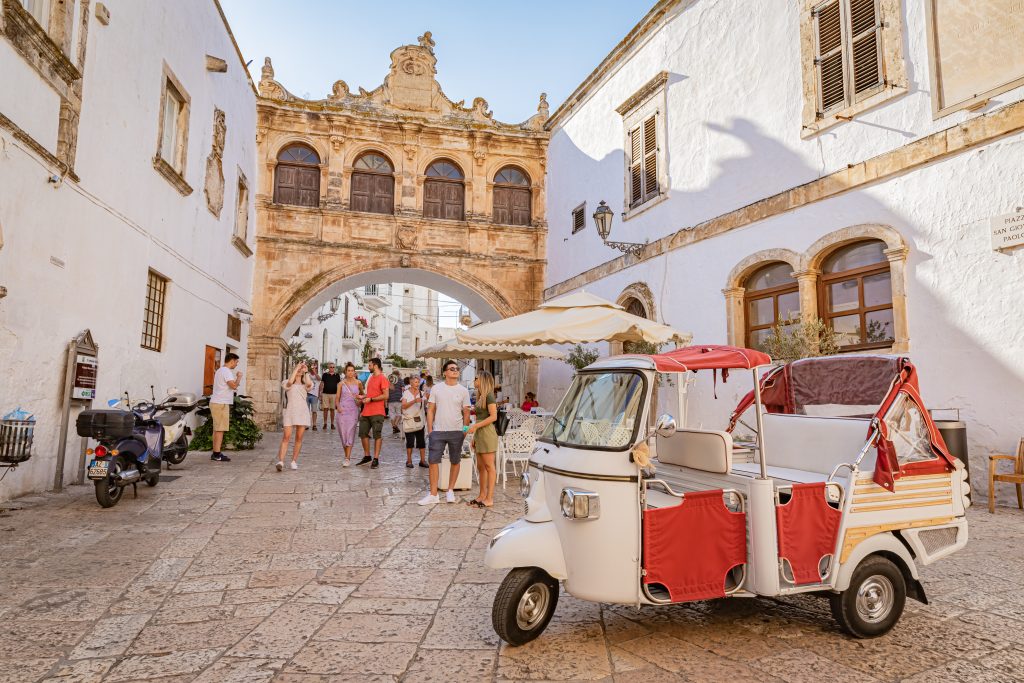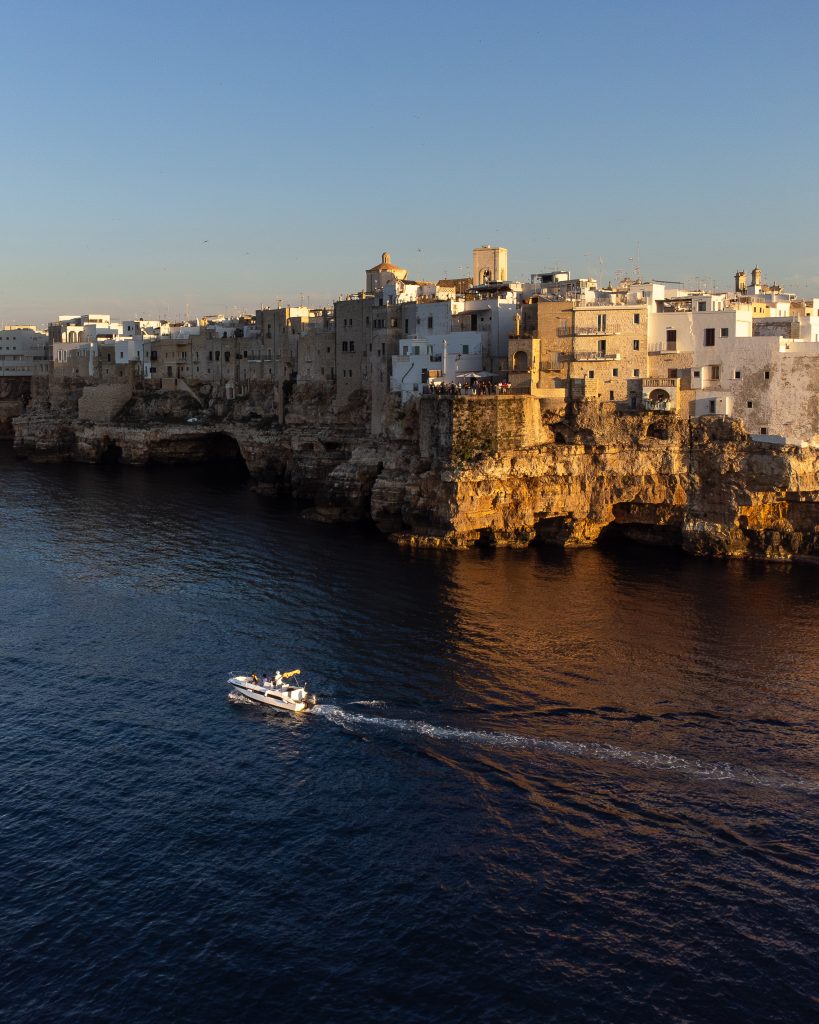Ostuni what to see: visit the white city

In this blog post, we will provide you with useful insights on what to see in Ostuni. But first, let’s start with why you should visit Ostuni.
Ostuni is one of the most famous and visited towns, as well as a favorite among tourists in the Salento peninsula, in Puglia, the quintessential white city.
It is famous worldwide for the white of the houses nestled like a pearl between the blue of the sky and the sea. A sight to see with your own eyes.
Why visit Ostuni?
Ostuni is spectacular and is called the “white city” because it is completely covered in white. The plaster on the walls amplifies the beautiful southern light, so much so that it won't even feel like you are in Italy but rather that you have landed on a Greek island.
The blue of the sky and the sea, sparkling a few kilometers away, creates an unreal atmosphere. If I had to paint a portrait of my idea of a Mediterranean summer, Ostuni would be the perfect subject.
Do you want another reason to visit Ostuni?
In addition to being renowned for its characteristic town center, Ostuni has received several awards for the beauty of its sea. It has collected as many as 5 sails and a special recognition from Legambiente for both the cleanliness of the coast and the services offered.
What to see in Ostuni and its surroundings

We are in the province of Brindisi, where, on a hill of the Murge, this wonderful village rises, famous for its whitewashed houses dominated by the Cathedral. The town is located 8 km from the Adriatic coast and is dotted with rows of ancient olive trees that make the landscape truly breathtaking.
1. What to see in Ostuni: the historic center
Begin your visit to Ostuni from the Historic Center of Ostuni, also known as the "old town," famous for its completely white houses thanks to the lime coating. Characterized by numerous alleyways that wind between the houses, many of which end in dead ends.
2. What to see in Ostuni: the Aragonese walls
A must-see in Ostuni are the Aragonese walls. Built in the late Middle Ages by the Angiò to repel the invasions of the Saracens, they were later expanded in the late 15th century by the Aragonese to counter the invasions of the Turks pushing from the Adriatic. The walls remain a beautiful testament to the city's ancient history, as well as an interesting collector of anecdotes and important moments from the area.
3. What to see in Ostuni: the Cathedral of Ostuni
Since the beginning of time, when you visit a city, you visit its churches! So you certainly can't miss the beautiful Cattedrale di Ostuni, in the upper part of the town, built thanks to Ferdinand of Aragon and Alfonso II, sovereigns of the Kingdom of Naples. The flamboyant Gothic style from the 15th century and the rose window, one of the largest in the world, will capture your attention. The façade features three elegant pointed arches, and the interior has three naves, with a precious painted ceiling and splendid Baroque chapels.
4. What to see in Ostuni: Sant'Oronzo obelisk
Almost 21 meters tall, you can't forget to visit the obelisk of Sant Oronzo, which is a tribute to the protector of the city, Sant'Oronzo himself. Carved in local stone in baroque style, the obelisk features Latin inscriptions and at its top is the statue of the Saint, depicted in the act of blessing the people. The cult of Sant'Oronzo is strong in the city, and there are many places dedicated to him.
5. What to see in Ostuni: the civic museum
For museum lovers, a visit to the Civic Museum of Ostuni is a must; it is one of the most important museums in the city. Inaugurated in 1989 within the former monastery of Santa Maria Maddalena dei Pazzi, it contains artifacts from the Messapian, medieval, and modern periods, found in areas adjacent to Ostuni. Inside, you can also see original artifacts that come directly from the Agnano Cave, which is part of the same circuit.
6. What to see in Ostuni: the Natural Archaeological Park
A about 2 km from the historic center of Ostuni is the Santa Maria di Agnano Natural Archaeological Park. Connected to the civic museum, this park focuses on the eponymous cave, site of ancient cults and rituals dating back 3,000 years, dedicated to a female figure. In this cave, which in the past was a true sanctuary, research has uncovered two burials known as “Ostuni 1” and “Ostuni 2,” complete with funerary equipment.
How to visit Ostuni?
To visit Ostuni in the best way, you should use your own feet, leave the car in the parking lots at the beginning of the town (near Piazza della Libertà) and venture into the narrow streets of the town.
If you want to explore in an original way, you can be accompanied by a very characteristic and comfortable "ape calessino" to tackle the hills of Ostuni.

Curiosity: do you know why it is called "white city"?
This name is due to the habit of whitewashing the houses with lime, a tradition that dates back to the Middle Ages. Thanks to this practice Ostuni was never struck by the plague, as lime is a natural disinfectant. Infections were stopped in their tracks, and the white city continued to thrive.
The beauty of Ostuni does not lie so much in the churches or museums, but in its delightful alleys.
To enjoy a unique experience in a fantastic city, you can book one of our guided tours:


